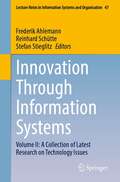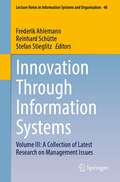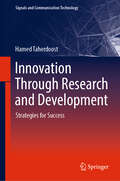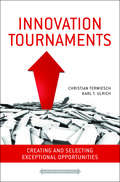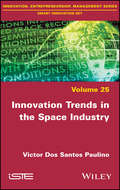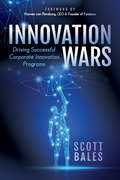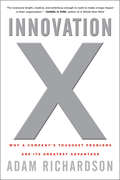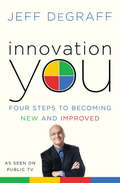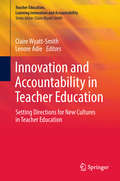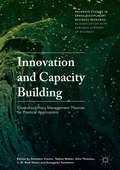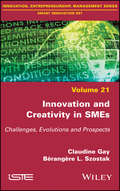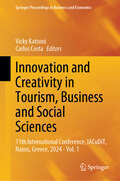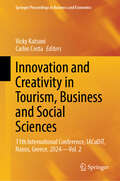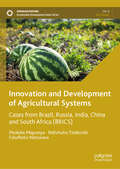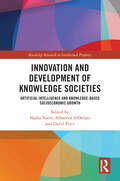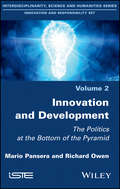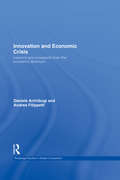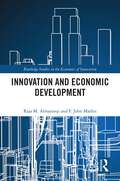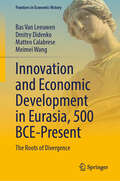- Table View
- List View
Innovation Through Information Systems: Volume II: A Collection of Latest Research on Technology Issues (Lecture Notes in Information Systems and Organisation #47)
by Stefan Stieglitz Frederik Ahlemann Reinhard SchütteThis book presents the current state of research in information systems and digital transformation. Due to the global trend of digitalization and the impact of the Covid 19 pandemic, the need for innovative, high-quality research on information systems is higher than ever. In this context, the book covers a wide range of topics, such as digital innovation, business analytics, artificial intelligence, and IT strategy, which affect companies, individuals, and societies. This volume gathers the revised and peer-reviewed papers on the topic "Technology" presented at the International Conference on Information Systems, held at the University of Duisburg-Essen in 2021.
Innovation Through Information Systems: Volume III: A Collection of Latest Research on Management Issues (Lecture Notes in Information Systems and Organisation #48)
by Stefan Stieglitz Frederik Ahlemann Reinhard SchütteThis book presents the current state of research in information systems and digital transformation. Due to the global trend of digitalization and the impact of the Covid 19 pandemic, the need for innovative, high-quality research on information systems is higher than ever. In this context, the book covers a wide range of topics, such as digital innovation, business analytics, artificial intelligence, and IT strategy, which affect companies, individuals, and societies. This volume gathers the revised and peer-reviewed papers on the topic "Management" presented at the International Conference on Information Systems, held at the University of Duisburg-Essen in 2021.
Innovation Through Research and Development: Strategies for Success (Signals and Communication Technology)
by Hamed TaherdoostThis book comprehensively covers various aspects of research and development (R&D). Intended for a classroom or professional setting, the book provides valuable insights into the significance of R&D for organizations, its role in enhancing processes, reducing costs, increasing efficiency, and fostering innovation. The author offers understanding of how R&D contributes to developing new technologies, products, and services that help companies remain competitive in dynamic marketplaces. The book delves into topics such as the fundamentals of R&D, its role in business, project management, performance management, success evaluation, risk management, team building, and practical execution of R&D projects. In essence, the book aims to be a comprehensive guide for students and professionals interested in understanding and effectively implementing R&D practices within various industries and sectors. The author includes case studies to enhance reader understanding byshowcasing successful R&D initiatives, challenges faced, and strategies employed to overcome them. By embracing a holistic approach, this book emerges as a forward-thinking guide that encourages readers to navigate the evolving landscape of R&D with a conscientious and innovative mindset.
Innovation Tournaments
by Karl Ulrich Christian TerwieschManagers, entrepreneurs, and venture capitalists all seek to maximize the financial returns from innovation, and profits are driven largely by the quality of the opportunities they pursue. Based on a structured and process-driven approach this book demonstrates how to systematically identify exceptional opportunities for innovation.An innovation tournament, just like its counterpart in sports, starts with a large number of candidates, with opportunities as the players. These opportunities are pitted against each other until only the exceptional survive.This book provides a principled approach for the effective management of innovation tournaments - identifying a wealth of promising opportunities and then evaluating and filtering them intelligently for greatest profitability. With a set of practical tools for creating and identifying new opportunities, it guides the reader in evaluating and screening opportunities. The book demonstrates how to construct an innovation portfolio and how to align the innovation process with an organization's competitive strategy.Innovation Tournaments employs quirky, fresh examples ranging from movies to medical devices. The authors' tool kit is built on their extensive research, their entrepreneurial backgrounds, and their teaching and consulting work with many highly innovative organizations.
Innovation Trends in the Space Industry
by Victor Dos Santos PaulinoEver since their inception, space activities have been innovative, but not driven by commercial considerations – that is, until the end of the Cold War, when the commercialization of space escalated. As a result, the direction of the innovation changed in order to leverage new business opportunities, which reached a turning point in the 2010s. This book discusses the developmental trends of the world space sector in detail, by analyzing their long-term evolution, and studying why this innovative industry sometimes experiences technological and organizational delays. Innovation Trends in the Space Industry also provides a framework to diagnose more accurately the potential technological threats that are currently faced by existing space tech manufacturers. Moreover, this book, with an economic perspective, provides a close examination of the space sector. It also contributes to enriching innovation management theory by leading us to better understand industry emergence shaped by customers, to reinterpret technological and organizational inertia in high technology activities, and to refine disruptive innovation trends.
Innovation Wars: Driving Successful Corporate Innovation Programs
by Scott Bales Hannes van RensburgInnovation Wars confronts the emotions of innovation and explains how innovation isn’t really about new ideas, but about the people who execute them. The modern economy brings a multitude of challenges for organizations. Digital culture has taken over as a prime driver of consumer behavior, startups are continuously disrupting traditional industries, and organizations are going out of business as a rising number have announced intentions to launch innovation labs or partner with nimbler organizations. The economy has evolved into a battlefield, full of attempts, failures, and successes.Innovation Wars provides new business designs, new tools, and new frameworks for today’s leaders to steer their organization towards success. Technology guru Scott Bales looks at the models of successful organizations, mapping out a strategic roadmap to success with a fresh take on the nature of innovation. He guides business leaders through a journey of self-reflection on their way to experimentation and value proposition discovery. Readers are given practical tools they can apply in their current organization to reduce the guess work in strategy and market success. They learn to do things the likes of Uber, Airbnb, and Amazon have done time and time again: harness the power of their voice to find new ways to solve old problems and unlock market frustration.
Innovation X
by Adam RichardsonA fresh approach to succeeding with innovation, grounded in insights about rapidly changing customers, competitors and technologiesWritten by a director at the award-winning global innovation firm frog design, this vital book shows business leaders and managers how to accomplish truly effective innovation in today's disruptive climate. Richardson shows how business is filled with "X-problems"- tough new challenges that present massive innovation opportunities, but also risks. Thriving in a world of X-problems requires harnessing four specific approaches: Immersion, Convergence, Divergence, and Adaption. Combining frog design's approaches with insightful analysis of companies such as Apple, BMW, Clif Bar, Google, Maxtor, and Salesforce.com, Richardson illustrates how to envision and realize successful new business ventures, products, and services.Provides a process for translating customer insights into relevant innovations, accompanied by case studies (many of them richly described from frog's own experiences)For the first time, gives real guidance on connecting products, software and services into ecosystems that are actually compelling to customersShows how to facilitate bringing multiple perspectives to understanding a problem domain, as well as how to manage an innovation portfolio over time Innovation X is an essential guide for companies seeking to create growth and differentiation in increasingly competitive markets.
Innovation You: Four Steps to Becoming New and Improved
by Jeff DegraffIn today's frenetic, uncertain world, the "same old, same old" routines are perfect ways to go nowhere fast. What has worked for you before--professionally or personally--no longer gets results. Whether you've been downsized, reached the end of a long relationship, or found yourself questioning where you are in life, it's clear you need to change. To innovate. Make it new. Make yourself new. Now, in this invaluable book, the world-renowned "Dean of Innovation," Jeff DeGraff, shares his tried-and-true techniques on how to reinvent yourself--creatively and with maximum impact.Innovation You reveals DeGraff's unique four-step program to bolster your ingenuity and remake your life. From forging ahead in a new career to losing weight to finally pursuing that long-held dream, DeGraff's strategies are effective and easy to follow. Inside you will learn to * Rethink Innovation: Find ways to think outside the box, seek out diverse opinions, and pay attention to the next great trend.* Rethink Your Approach: Use the Competing Values Framework to identify your natural innovation profile--do you compete, collaborate, create, or control?--and then deliberately draw from the other styles to augment your usual tactics.* Rethink Your Methods: Put your reinvention plan in motion--set specific, realistic, and meaningful targets, cultivate relationships with relevant mentors and experts, and try alternate methods to achieve your goals.* Rethink the Journey: Understand that innovation is a process and that progress comes in cycles rather than a quick straight line. Accept uncertainty, question assumptions, and acknowledge areas where you can improve. Full of invigorating ideas, engaging anecdotes, practical wisdom, and inspiring success stories, Innovation You is your personal road map to reach your highest potential--and experience a bold new way of living.From the Hardcover edition.
Innovation and the Social Economy
by Marie J. BouchardSocial economy organizations such as cooperatives, non-profits, mutual benefit groups, foundations, and non-governmental organizations are uniquely positioned to respond not only to emerging social and economic needs, but also to new collective aspirations. In Québec, for instance, a pioneering social economy system has been developed that is recognized worldwide for its ability to foster innovative solutions to economic disparity and sustainability issues. In the wake of a global crisis that has emphasized the growing gap between economic and social concerns, what can other regions gain from this model?Through robust theoretical and in-depth empirical studies, this book offers the first opportunity to English-language readers to learn about the Québec experience of a social economy system. It takes stock of recent developments in the province relating to policy planning, governance, financing, local development, and legal frameworks. Innovation and the Social Economy also emphasizes this system's potential for exploring alternative practices of production, consumption, and distribution that can foster social transformation.
Innovation and Accountability in Teacher Education: Setting Directions for New Cultures in Teacher Education (Teacher Education, Learning Innovation and Accountability)
by Claire Wyatt-Smith Lenore AdieThis is the foundational book for the new series, Teacher Education, Learning Innovation and Accountability. The book canvasses research, practice and policy perspectives in teacher education across diverse geographic, social and political contexts. It explores the lifespan of teacher development from initial preparation through to graduate classroom practice as it occurs in an intensifying culture of standards and regulation. The characterization of initial teacher education (ITE) in a crucible of change permeates throughout the book. The chapters open up new ways of thinking about innovation and accountability in ITE and the professionalization of teaching, exploring fundamental questions, such as “Who are the actors in teacher preparation and how do they interact? How can we learn about the quality of teacher education? Where can we hear the voices of teacher educators and preservice teachers, as well as school-based teacher educators? What are the new and emerging roles of others in teacher education who have not been involved previously, including employing authorities?” (p. 22). While the book provides responses to these and other provocative questions, it also offers new insights into innovative teacher education from a wide range of policy and practice contexts.
Innovation and Business Partnering in Japan, Europe and the United States (Routledge Studies in the Growth Economies of Asia #Vol. 67)
by Ruth TaplinInnovation studies and partnering/collaborative alliances are rapidly growing areas of interest. Originally combining the two areas, this book examines the role of business partnering as a pathway to innovation for small and medium enterprises – SMEs. This text outlines global and regional trends, focusing in particular on the role of Poland and Eastern Europe as an emerging region for new innovative ideas, how innovation is promoted in the United States, and how it is facilitated in Japan. It assesses the reasons why American SMEs are significantly ahead of their European counterparts in the fields of research and development investment and innovation, and demonstrates how business partnering can assist in increasing research and development investment, profit, finding new suppliers and aiding growth. In addition, the book shows how business partners can cut the costs of doing research for innovation and analyzes the threat that poorly constructed and over-burdensome regulation and bureaucracy pose to innovation. This book is a timely contribution to the literature on both innovation and business partnering in Japan, Europe and the United States.
Innovation and Business in Emerging Markets
by Tarun Khanna Geoffrey G. Jones Nataliya Langburd Wright Morgan SpencerCase
Innovation and Capacity Building: Cross-disciplinary Management Theories for Practical Applications (Palgrave Studies in Cross-disciplinary Business Research, In Association with EuroMed Academy of Business)
by Demetris Vrontis Yaakov Weber Alkis Thrassou S. M. Shams Evangelos TsoukatosThis book explores how contemporary organisations are abandoning conventional tactics in order to survive and grow in an incessantly shifting business landscape, analysing fundamental aspects of management, marketing and strategy from an interdisciplinary perspective. Focusing on the paradigms of neuro-marketing, innovative change management, motivational creativity, and customer data management, to name a few, the authors provide practical learning outcomes which reflect how organisations are seeking to adopt innovative means to innovative ends, targeting capacity building in multiple ways. Ultimately, this edited collection implicitly defines an organisational philosophy that incorporates functionality, but also embraces business notions pertaining to wider contextual transformations and environmental developments. Theoretical and practical contributions highlight the importance of multidisciplinary research to practical business success, making this book an invaluable read to both scholars and business executives.
Innovation and Change in Japanese Management
by Parissa Haghirian'Innovation and Change in Japanese Management' shows which transformation processes and changes can be observed in Japanese companies in reaction to the economic challenges of the past decade. The book presents new research results and investigates the variety of changes that Japanese corporations and managers have experienced in recent years.
Innovation and Collaboration at Merrill Lynch
by Boris Groysberg Ingrid VargasIn the spring of 2005, Candace Browning, head of Global Securities Research and Economics at Merrill Lynch, led about 500 Merrill Lynch analysts worldwide in a collaborative effort to produce innovative research, most of them accustomed to working independently in their own regions and areas of expertise. Less than five years earlier, research analysts had expressed little or no interest in group efforts. By 2005, many analysts who had been assigned to work on collaborative projects indicated increased learning and a willingness to work in teams again. Some analysts themselves chose to work together. Whereas Merrill had come a long way, some analysts remained skeptical. Managers also questioned whether all types of collaboration were worth the significant efforts required. Browning had to consider the issues involved, the feedback received, and the industry itself and devise a strategy moving forward.
Innovation and Corporate Renewal
by James M. UtterbackThis chapter addresses the perennial management issue of how corporations can renew their technology, products, and processes as a basis for continued competitive vitality.
Innovation and Creativity in SMEs: Challenges, Evolutions and Prospects
by Claudine Gay Berangere SzostakIn order to survive in their market and differentiate themselves from the competition, small- and medium-sized enterprises (SMEs), which represent more than 90% of companies worldwide, need to be creative and innovative. This book presents a conceptual framework for thinking about innovation and creativity in SMEs. It takes into account their strategic relation to their environment and the economic, technological and social changes that they face. Their ability to enhance their creativity with new ideas and to legitimize them during their implementation is also taken into account
Innovation and Creativity in Tourism, Business and Social Sciences: 11th International Conference, IACuDiT, Naxos, Greece, 2024 - Vol. 1 (Springer Proceedings in Business and Economics)
by Carlos Costa Vicky KatsoniThis book is the first volume of the proceedings of the 11th International Conference of the International Association of Cultural and Digital Tourism (IACuDiT). Focusing on &“Innovation and Creativity in Tourism, Business and Social Sciences,&” the conference was held from September 3 to 5, 2024, in Naxos, Greece. The book showcases the latest research on tourism business, technology, and the social sciences and presents a critical academic discourse on ICT adoption in the social sciences, regional development; sustainability and tourism experience; smart and sustainable practices; innovations in museum interpretation and collections management; emerging and disruptive technologies; gaming, gamification and augmented reality, and other topical aspects in business and the social sciences. The book discusses these digital transformation processes from various standpoints, including its effect on the social sciences combined with specific forms of tourism. The impact of digitalization encourages the emergence of new digital products and services based on the principle of flexibility. The book focuses on the knowledge economy and the &“smart destinations&” concepts and highlights new modes of tourism management and development, while further chapters address emerging technologies, such as the Internet of Things, AI, big data, and robotics in a range of tourism practices.
Innovation and Creativity in Tourism, Business and Social Sciences: 11th International Conference, IACuDiT, Naxos, Greece, 2024 - Vol. 2 (Springer Proceedings in Business and Economics)
by Carlos Costa Vicky KatsoniThis book is the second volume of the proceedings of the 11th International Conference of the International Association of Cultural and Digital Tourism (IACuDiT). Focusing on &“Innovation and Creativity in Tourism, Business and Social Sciences,&” the conference was held from September 3 to 5, 2024, in Naxos, Greece. The book showcases the latest research on tourism business, technology, and the social sciences and presents a critical academic discourse on ICT adoption in the social sciences, regional development; sustainability and tourism experience; smart and sustainable practices; innovations in museum interpretation and collections management; emerging and disruptive technologies; gaming, gamification and augmented reality, and other topical aspects in business and the social sciences. The book discusses these digital transformation processes from various standpoints, including its effect on the social sciences combined with specific forms of tourism. The impact of digitalization encourages the emergence of new digital products and services based on the principle of flexibility. The book focuses on the knowledge economy and the &“smart destinations&” concepts and highlights new modes of tourism management and development, while further chapters address emerging technologies, such as the Internet of Things, AI, big data, and robotics in a range of tourism practices.
Innovation and Development of Agricultural Systems: Cases from Brazil, Russia, India, China and South Africa (BRICS) (Sustainable Development Goals Series)
by Fulufhelo Netswera Ndivhuho Tshikovhi Phokele MaponyaThis book focuses on innovations in agriculture that is aimed at eliminating global hunger and poverty and promoting sustainable development of global agriculture. Collectively, chapters in the book address innovations of BRICS Agricultural Food System, future actions of BRICS Agricultural cooperation, the impact of epidemics on agricultural investment and trade transactions in BRICS, and how BRICS countries can provide solutions for global grain and agriculture governance under the impact of the epidemic. In doing so, it highlights technological advancement tools and solutions in agribusiness value chain in emerging economies towards the Sustainable Development Goals of the United Nations, with a particular focus on SDG2: Zero Hunger.
Innovation and Development of Knowledge Societies: Artificial Intelligence and Knowledge-Based Socioeconomic Growth (Routledge Research in Intellectual Property)
by Nadia Naim, Alhanoof AlDebasi and David PriceThis book examines the role that intellectual property plays in fostering innovation within knowledge societies, with a particular focus on the role of emerging technologies such as Artificial Intelligence tools.Creativity and the generation of new knowledge across the broad spectrum of intellectual property are essential sources of growth for knowledge societies. This includes the major areas of copyright, inventions and patents, trademarks and geographical indications. This book acknowledges the societal and cultural character of knowledge societies, discussing how Intellectual Property (IP) Law plays a pivotal role in safeguarding innovation, thereby fostering evolution. As emerging technologies and artificial intelligence redefine the landscape, the book identifies both new challenges and opportunities in enhancing innovation prowess and nurturing knowledge societies. Suggesting regulations which prioritise copyright, trademarks and patents as fundamental instruments in international commerce, the book presents a framework for IP Law through which knowledge societies can thrive.The book will appeal to researchers in the field of Intellectual Property Law, international law, business law and emerging technologies such as AI.
Innovation and Development: The Politics at the Bottom of the Pyramid
by Richard Owen Mario PanseraInnovation, often tempered by the language of inclusion, has become an indispensable element of contemporary development policy and practice in the so-called Global South. Driven by multinational companies, public–private partnerships and social enterprises, “innovation for development” aims to co-produce social goods (things of value) such as poverty alleviation with associated profit through innovative market-led solutions, opening up untapped and unserved markets in the developing world and exploiting the potential “fortune at the bottom of the pyramid”. But innovation for development is a contested notion with the capacity to shelter multiple political agendas. By reviewing existing academic theory and discussing four in-depth case studies from Bangladesh and India, this book interrogates how innovation for development is being framed, its politics and the impacts it is having on rural communities on the ground. The analysis suggests both an emerging hegemony constructed around a neoliberal, market-led agenda and the existence of countervailing voices that question this framing, sometimes radically so.
Innovation and Economic Crisis: Lessons and Prospects from the Economic Downturn (Routledge Studies In Global Competition Ser. #53)
by Daniele Archibugi Andrea FilippettiThe recent financial and economic crisis has spurred a lot of interest among scholars and public audience. Strangely enough, the impact of the crisis on innovation has been largely underestimated. This books can be regarded as a complementary reading for those interested in the effect of the crisis with a particular focus on Europe.
Innovation and Economic Development (Routledge Studies in the Economics of Innovation)
by Raja M. Almarzoqi F. John MathisOver the past two decades, several sudden, unforeseen, and significant changes have occurred in the world's political and economic landscape. This book explores their impact on the processes of contemporary disruptive innovations during the Fourth Industrial Technology Revolution and the role that global finance and international commerce play. The expansion of multinational corporations, increasing dependence on global supply chains, and the globalization of the world economy have aided the rising expansion of Innovations worldwide.The authors analyze the drivers and relationship between these increasingly dispersed Innovations and the expanding linkage between economic growth in developed and developing countries. Progress will continue with technological innovations in financial services, lowering the cost to consumers and companies. Financial transactions will be executed increasingly by the individual using their cell phone or computer. Electronic digital payments and banking will replace currency.This book focuses on Innovations in advanced countries and examines developments in emerging markets and the implications for the world's future economic growth. The collaborative expansion and dispersion of online education across different cultures impact labor markets, diversity and immigration, and the rise and expansion of women entrepreneurial Innovators. The progression of global access to higher levels of education is changing the culture, values, and institutional foundations supporting Innovation.Knowledge of the expanding Innovation Ecosystems is crucial for understanding contemporary global business and entrepreneurship, international trade and capital flows, and investments impacting world history and economic, social, and political sciences subjects.
Innovation and Economic Development in Eurasia, 500 BCE-Present: The Roots of Divergence (Frontiers in Economic History)
by Bas Van Leeuwen Dmitry Didenko Matteo Calabrese Meimei WangThis book explores the long-term economic growth of three key regions: China, Central Eurasia, and Western Europe. It discusses why some areas experienced faster, and more sustained growth than others by focusing on how new ideas are created (innovation), how different countries use these ideas (adoption), and how these factors influence long-term economic differences and similarities (divergence/convergence). These key drivers are examined across time and throughout different regions, considering factors like state involvement, urbanization, the development of specific resources (e.g., fertile land), labor relations, and prices and wages. The book presents new research, connects chapters with recurring themes, and offers combined explanations. Without getting stuck in purely theoretical or historical discussions, it thus goes beyond the various theories to study how the nations caught up, fell behind, and forged ahead in GDP and immaterial well-being. Finally, the book highlights that, while there is value in understanding various existing theories, it is important to acknowledge the complexities in each region's specific historical and regional context.
